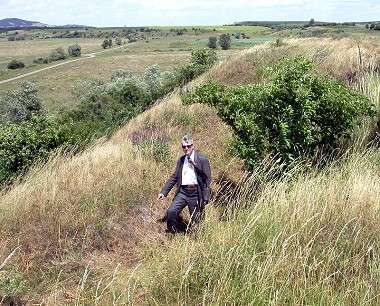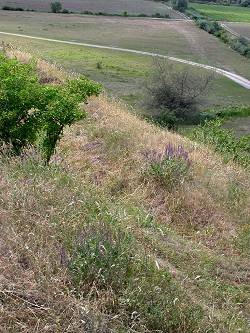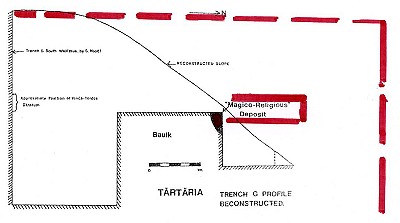

Some scholars, perhaps in an effort to explain the incongruity of the signs on the tablets with their expectations, have insinuated that they were intruders into the Vinča layer from later and higher levels. Ruth Tringham [39] and Sarunas Milisauskas [40] asserted that the pit may have been dug near the Turdaşş layer, but not belonging to it. This conjecture suggests a later date for the tablets agreeing with the views of some scholars such as Georgiev, [41] Neustupny, [42] Dumitrescu, [43] and Whipp. [44] David G. Zanotti [45] advanced the supposition that they were intrusive from the upper strata most likely connected with the bronze age presence on the site, in particular with Baden-Kostolac culture. This would date the tablets between 5,400 and 5,000 years ago, or contemporary with Uruk IV and Jemdet Nasr periods in Mesopotamia and make their signs compatible with the Sumerian analogies detected by Adam Falkenstein, who synthesized them in a chart, [46] and later Sinclair Hood. [47] In the Zanotti assumption, Vlassa actually found the inscribed artifacts in a pit dug from the Vinča-Turdaşş level but they had been buried in a very superficial stratum on the steep north-western slope of the mound, and characterized by a mixed archaeological context. The tablets could have intruded from that upper stratum and in fact could have been a product of the trade or the reflux movement of tribes returning to the Aegean. [48]  Challenging Tringham, Milisauskas, Zanotti and other scholars assumptions, how can one assert that bones and tablets are synchronous? Firstly let me point out that these scholars are following an obsolete chronology. They don't consider that the Turdaşş culture they refer to was born on a Vinča B basis and developed after the Vinča C migrations with the concomitant social shock and cultural collision. Therefore it is more recent than Milady Tărtăria and belongs to the Late Neolithic such as the Tisa, Stoicani-Aldeni and Precucuteni cultures. [49]  Secondly one has to consider how the tablets' intrusion happened in the Zanotti reconstruction. In the hope of ascertaining the true location of the Tărtăria tablets, he attempted to recreate via computer the area of trench G (where the tablets were found) as it was prior to the 1961 dig. Using a combination of map enlargements, sections and Vlassa's original photographs, he hypothesized the proximity of the ritual pit to the original surface prior to the excavation. But in his artificial and untested study he didn't consider that the river once ran underneath the settlement and had eroded a side of it. The very steep riverbank still proves this and the line of the ancient course can be traced beneath. This natural phenomenon gave the slope a different inclination from that presumed by Zanotti. His reconstruction of the sediments is only valid not before but after the Vlassa excavation; surely it must have looked different four thousand years ago, at the time of the Baden-Kostolac culture. Secondly one has to consider how the tablets' intrusion happened in the Zanotti reconstruction. In the hope of ascertaining the true location of the Tărtăria tablets, he attempted to recreate via computer the area of trench G (where the tablets were found) as it was prior to the 1961 dig. Using a combination of map enlargements, sections and Vlassa's original photographs, he hypothesized the proximity of the ritual pit to the original surface prior to the excavation. But in his artificial and untested study he didn't consider that the river once ran underneath the settlement and had eroded a side of it. The very steep riverbank still proves this and the line of the ancient course can be traced beneath. This natural phenomenon gave the slope a different inclination from that presumed by Zanotti. His reconstruction of the sediments is only valid not before but after the Vlassa excavation; surely it must have looked different four thousand years ago, at the time of the Baden-Kostolac culture.
Gheorghe Lazarovici and Zoia Maxim made a topographic survey on this controversial point and presumed that in Neolithic times the settlement did not have an eroded tell shape but it laid on a terrace and its limit was at a minimum distance of 10-15 meters. The conclusion is that the feature of the pit and the tablets' position were not disturbed by the Baden-Kostolac pit (30-40 cm) which is supposed by Zanotti to have cut as deep as 2 meters. The leakage angle of the reconstructed slope by Zanotti measures around 45° but in reality it is 70-80°; a fact which indicates that the erosion was natural and intense. [50] One should also consider that the ritual pit is too narrow to allow a falling down of the tablets and the accompanying pile of artifacts. Lazarovici and Maxim criticized the Zanotti doubts in very harsh terms, considering them "unreasonable or naive" and his remarks to be "childish and untrue". And Milisauskas in a recent work carefully avoids taking part in the controversy. [51]  | |
Merlini Tărtăria | 1 | 2 | 3 | 4 | 5 | 6 | 7 | 8 | 9 | 10 | 11 | 12 | 13 | 14 | 15 | |